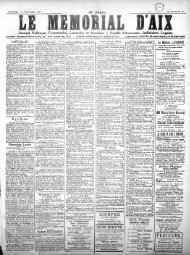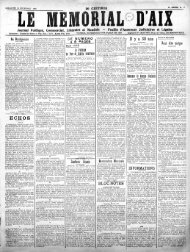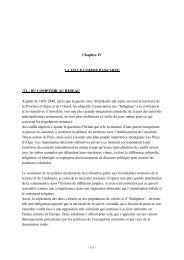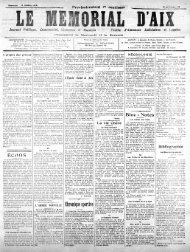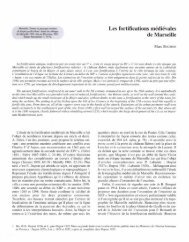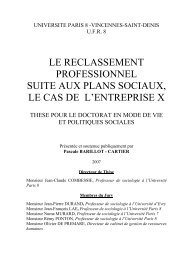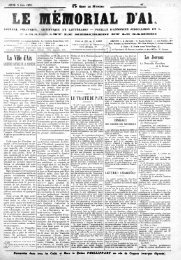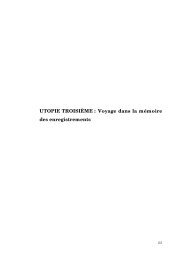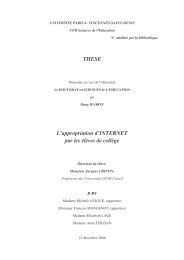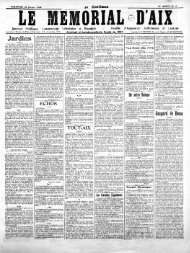- Page 6 and 7:
INTRODUCTION
- Page 8 and 9:
8D’après Mustapha CHELBI, « rie
- Page 10 and 11:
10le fait du hasard. Étant nous-m
- Page 12 and 13:
12Les deux répertoires ont-ils une
- Page 14 and 15:
PREMIERE PARTIETradition mystique e
- Page 16 and 17:
161- Qu'est ce que le soufisme ?1.1
- Page 18 and 19:
18de "l’âge d'or", époque où t
- Page 20 and 21:
20musiciens de la cour ottomane et
- Page 22 and 23:
22l'édification d'un nouveau pouvo
- Page 24 and 25:
24D’après Sadok RIZGUI, les turu
- Page 27 and 28:
272- La dimension mystiqueA travers
- Page 29 and 30:
291/ Une cellule ou une branche d'u
- Page 31 and 32:
31firqa (la formation musicale qui
- Page 33 and 34:
333.1- Son rôle socialEn tant qu
- Page 35 and 36:
35et des marabouts"(28). Elle est d
- Page 37 and 38:
37formation musicale en assistant a
- Page 39 and 40:
39Le shaykh Ahmad al-WÂFÎWÂFÎ (
- Page 41 and 42:
413.3.2 - Le shaykh Khmayyess TARN
- Page 43 and 44:
43En assistant à ces concerts de m
- Page 45 and 46:
45Le shaykh BÛDAYYA a même enregi
- Page 47 and 48:
471- Biographie d'Abû-l-Hassan al-
- Page 49 and 50:
49TraductionPoint doute sur sa nais
- Page 51 and 52:
51artistique, notamment dans le dom
- Page 53 and 54:
53Il n'est pas sans intérêt de si
- Page 55 and 56:
55Il n'aura vécu que soixante-dix
- Page 57 and 58:
57en pleine expansion. Cette interv
- Page 59 and 60:
59a été un gouverneur exécrable,
- Page 61 and 62:
61d'exemple, Abu-l-Fadhl Qâsim al-
- Page 63 and 64:
63Plan de la médina de Sfax (69)In
- Page 65 and 66:
65La zâwiya de sîdî Abû-l-Hassa
- Page 67 and 68:
67marbre, au style arabesque. Le to
- Page 69 and 70:
69la banlieue de Sfax, ainsi que pl
- Page 71 and 72:
71déroulement des différentes pra
- Page 73 and 74:
73la bonne fortune) (77). Cette lec
- Page 75 and 76:
75du pèlerinage et de la visite de
- Page 77 and 78:
Troisième chapitreLa a musique dan
- Page 79 and 80:
79ta démarche et parle sur un ton
- Page 81 and 82:
812/ - Musique pratiquée avec des
- Page 83 and 84: 83Transcription d'un tartîl de la
- Page 85 and 86: 85Transcription d'un tajwjwîd de l
- Page 87 and 88: 87Texte de l'âdhân en langue orig
- Page 89 and 90: 89L'âdhân se fait cinq fois par j
- Page 91 and 92: 91cérémonies religieuses. Sa forc
- Page 93 and 94: 93kilomètres au Nord de Sfax, et a
- Page 95 and 96: 95Bâsh-shâwish [le chef des shuww
- Page 97 and 98: 97générale en des panégyriques
- Page 99 and 100: 99Tout comme la `Awâmriyya, le fon
- Page 101 and 102: 101qui est la hadhra, et qui donne
- Page 103 and 104: 103fonda pas sa tarîqa et ne compt
- Page 105 and 106: 105saqqâ' ou de bâsh `Allâm car
- Page 107 and 108: 107musique a commencé à s’insé
- Page 109 and 110: 109l'originalité de sa composition
- Page 111 and 112: 111sur des feuilles de cactus; coll
- Page 113 and 114: 113essentiels la glorification du D
- Page 115 and 116: DEUXIEME PARTIEAnalyse musicale et
- Page 117 and 118: 1171 - Les caractéristiques du sys
- Page 119 and 120: 119L'échelle du tba` est essentiel
- Page 121 and 122: 121Les arabes ont donnés le nom de
- Page 123 and 124: 123B/ Les ajnâs partants de la not
- Page 125 and 126: 125D/ Le jins partant de la note Fa
- Page 127 and 128: 127inspirations populaires, notamme
- Page 129 and 130: 129Le temps fort (dum) , , ⎩ …
- Page 131 and 132: 131fait être introduit dans une me
- Page 133: 1331 - La nûbaLittéralement, le t
- Page 137 and 138: 137Au XIV ème siècle, et selon un
- Page 139 and 140: 139l'origine une improvisation de s
- Page 141 and 142: 1413/ al-Abyât: (sing. bayt: vers)
- Page 143 and 144: 1435/ at-tûshya : c'est une pièce
- Page 145 and 146: 145Il est à noter que cette partie
- Page 147 and 148: 147même une nûba entière, comme
- Page 149 and 150: 149Raçd adh-dhîl m'entoure,Puis l
- Page 151 and 152: 1513.2 - `IRAQ : (ou I`râq comme l
- Page 153 and 154: 153Phrase mélodico rythmique carac
- Page 155 and 156: 155tort, aux esclaves, c'est-à-dir
- Page 157 and 158: 1573.7 - Nwâ : "nwa est la prononc
- Page 159 and 160: 159Phrase mélodico rythmique carac
- Page 161 and 162: 161Phrase mélodico rythmique carac
- Page 163 and 164: 163La gamme modale :Phrase mélodic
- Page 165 and 166: 165Nous avons indiqué, en chiffres
- Page 167 and 168: Troisième chapitreLes caractérist
- Page 169 and 170: 16864Il est à remarquer que dans l
- Page 171 and 172: 1701.13 - al-Barâwil (sing. barwal
- Page 173 and 174: 172qui comporte douze unités de te
- Page 175 and 176: 174formés que de consonnes lingual
- Page 177 and 178: 176- Quatre dans le tba` hsîn,- Hu
- Page 179 and 180: 1782.1 - Le tba` dhîl :Ce tba` occ
- Page 181 and 182: 180Wa-hmidhu `an kulli hâlawa-tlib
- Page 183 and 184: 182Les paroles du btâyhî que nous
- Page 185 and 186:
184- Jins dhîl en do2 (râst), il
- Page 187 and 188:
186* les trois premières mesures d
- Page 189 and 190:
1882 ème mouvement : Un btâyhî "
- Page 191 and 192:
190Abû-l-Hassan Karrâyshakhî bih
- Page 193 and 194:
192C'est un muwashshah qui, dans le
- Page 195 and 196:
194Un deuxième barwal " Yâ hâdî
- Page 197 and 198:
196trente-huit vers se trouve dans
- Page 199 and 200:
198Un quatrième barwal "Yâ Rabbî
- Page 201 and 202:
200Notons que ce jins est le jins p
- Page 203 and 204:
202Les degrés fondamentaux ou note
- Page 205 and 206:
204Une princesse, fière et hautain
- Page 207 and 208:
206Un troisième btâyhî "Yâ shyk
- Page 209 and 210:
208Ta`tifû `an hâdha-l-mutayyamHa
- Page 211 and 212:
2102.1.31 Étude analytiqueLe chant
- Page 213 and 214:
212comme dans le dukhûl barâwil "
- Page 215 and 216:
214D'après cette partie de nûba,
- Page 217 and 218:
216- Qad bâna shawqî yâ `adhûl.
- Page 219 and 220:
2182 ème mouvement : il comprend u
- Page 221 and 222:
220Ensuite beaucoup de louanges ser
- Page 223 and 224:
2222- Un deuxième barwal: "Yâ Il
- Page 225 and 226:
2243- Un troisième barwal:"Asqîn
- Page 227 and 228:
226répertoire des majâlis de sîd
- Page 229 and 230:
228- jins mhayar`irâq en sol2 (naw
- Page 231 and 232:
230Qafla (2)Qafla (3)2.3 - Le tba`
- Page 233 and 234:
232Bi haqqi tâha-l-muçtafâ badru
- Page 235 and 236:
234Nawwar qulûb 'ahli-l-kamâliRij
- Page 237 and 238:
236Fî dhulmati-ghasaqiyâ hubbîY
- Page 239 and 240:
238Yâ shaykh yâ sultânYakfî min
- Page 241 and 242:
240L'exploration de ce jins suit le
- Page 243 and 244:
242Au cours de l'examen et l'analys
- Page 245 and 246:
244des marabouts. Le texte des paro
- Page 247 and 248:
246Man sharib lam yatiq çabrâ fa
- Page 249 and 250:
248Faydhan yuwâfiqnâBi haqqi taha
- Page 251 and 252:
250Comme dans le btâyhî "yâ Rabb
- Page 253 and 254:
252des degrés constitutifs du tba`
- Page 255 and 256:
254Cette troisième partie de la n
- Page 257 and 258:
256Un deuxième dukhûl barâwil :
- Page 259 and 260:
258Un troisième dukhûl barâwil :
- Page 261 and 262:
260Le chant du premier dukhûl bar
- Page 263 and 264:
262Les degrés fondamentaux ou note
- Page 265 and 266:
264le premier degré pour bien inst
- Page 267 and 268:
266- Idhâ dhâqa çadrî- Nibda' b
- Page 269 and 270:
268Puisse-t-il nous défendre le jo
- Page 271 and 272:
270N'es tu pas l'homme parfait,Je m
- Page 273 and 274:
2724 ème mouvement : Il comprend t
- Page 275 and 276:
274Yâ 'bâ-l-Hassan yâ Karrâyyâ
- Page 277 and 278:
276Le chant des quatre mouvements d
- Page 279 and 280:
278Comme dans les neuvième et dixi
- Page 281 and 282:
280Qafla 5 :2.4.2 - la suite du tba
- Page 283 and 284:
282-Un deuxième dukhûl barâwil :
- Page 285 and 286:
284Transcription musicale :- Un tro
- Page 287 and 288:
2862 ème mouvement : il comprend d
- Page 289 and 290:
288Dans le manuscrit, c'est le quat
- Page 291 and 292:
290Parcours 2Comme dans le troisiè
- Page 293 and 294:
292D'après cette suite, l'étendue
- Page 295 and 296:
2942.6 - Le tba` raçd :La nûba co
- Page 297 and 298:
296- sammayt bism-l-Lâh- yâ Ilâh
- Page 299 and 300:
298- Yâ lâyem fa-kfuf lawmak- Mis
- Page 301 and 302:
300Un deuxième btâyhî "Yâ sâq
- Page 303 and 304:
302Un barwal "idhâ dhakarta-n-naq
- Page 305 and 306:
304Le chant de ces deux mouvements
- Page 307 and 308:
306D'après ces deux btâyhî et ce
- Page 309 and 310:
308Translittération du texte arabe
- Page 311 and 312:
310Translittération du texte arabe
- Page 313 and 314:
312Wa bi madhihi naftah wa naftakhi
- Page 315 and 316:
314suivant :- Jins mazmûm en fa2 (
- Page 317 and 318:
316- Munâ'î khamrâ- Qad bpana sh
- Page 319 and 320:
318numéro quatre-vingt quatorze. E
- Page 321 and 322:
320Transcription musicale :2 ème m
- Page 323 and 324:
322Transccription musicale :Tableau
- Page 325 and 326:
324muwashshah) forment les treize n
- Page 327 and 328:
326- "Parmi les paroles de sîdî A
- Page 329 and 330:
3283.1 - Les formesComme nous l'avo
- Page 331 and 332:
330D______________D______________L_
- Page 333 and 334:
332est méprisé par les poètes (1
- Page 335 and 336:
334Exemple :2/ - L'éloge du Proph
- Page 337 and 338:
336Ornée d'or si bien aligné,Tu n
- Page 339 and 340:
338Traduction :Je débute mon poèm
- Page 341 and 342:
Quatrième ChapitreLes instruments
- Page 343 and 344:
335milieux ruraux, et parfaitement
- Page 345 and 346:
337La hadhrade Muhammad BÛDAYYA (1
- Page 347 and 348:
339La fonction de la zukra, seul in
- Page 349 and 350:
341Le cadre est percé d'un orifice
- Page 351 and 352:
3431.3 - La darbûkaC'est un instru
- Page 353 and 354:
345pour le réglage de la tension d
- Page 355 and 356:
347Comme nous l'avons avancé plus
- Page 357 and 358:
Transcription musicale349
- Page 359 and 360:
351Sauves moi, tu nous l'as promis
- Page 361 and 362:
353Translittération du texte arabe
- Page 363 and 364:
355
- Page 365 and 366:
357séquence instrumentale qui inci
- Page 367 and 368:
3592.2 Le târC'est un tambourin su
- Page 369 and 370:
361transitions et les arrêts (qafl
- Page 371 and 372:
363`ûd tunisien (192)Le `ûd tûns
- Page 373 and 374:
365
- Page 375 and 376:
367Un premier barwal. Juste après
- Page 377 and 378:
369Un deuxième barwal "Isqînî y
- Page 379 and 380:
371nous vu, la soumission à la par
- Page 381 and 382:
2Cette étude a eu pour objectif de
- Page 383 and 384:
4qu’il s’agit du même réperto
- Page 385 and 386:
6professionnels à se spécialiser
- Page 387 and 388:
379AAbyâtAçlAdhkârAdwârÂdhânA
- Page 389 and 390:
381FâtihaFhallFiqhFiraqFirqaFrûd
- Page 391 and 392:
383MaqâmMarâkizMarkazMatla`Mazmû
- Page 393 and 394:
385TTaçawwufTajwîdTa`mîrTâkTâm
- Page 395 and 396:
Bibliographie commentéecommentée
- Page 397 and 398:
389Une etude portant sur l'histoire
- Page 399 and 400:
391BARKECHLI (Mehdi), "Les échelle
- Page 401 and 402:
393BUCHNER (Alexandre), "Encyclopé
- Page 403 and 404:
395COMITE SUPERIEUR DE LA MUSIQUE,
- Page 405 and 406:
397Ce recueil contient une préface
- Page 407 and 408:
399complète sur les systèmes tona
- Page 409 and 410:
401FASI (Muhammad), "Al-mûsîqâ a
- Page 411 and 412:
4032 - du VIème au VIIème siècle
- Page 413 and 414:
405IBN ABI DHIAF (Ahmad), "Ithâf a
- Page 415 and 416:
407Yûsif, le Caire, Imprimerie Nat
- Page 417 and 418:
409Cette préface qui relate la vie
- Page 419 and 420:
411Le premier tome de l'ouvrage est
- Page 421 and 422:
413MASS`UDI (Abû al-Hasan `Alî Ib
- Page 423 and 424:
415Etude intéressante sur la théo
- Page 425 and 426:
417ROUGET (Gilbert), "La musique et
- Page 427 and 428:
419Etude sérieuse et bien document
- Page 429 and 430:
Table des matières
- Page 431 and 432:
4233. les lieux de culte (zawâyâ)
- Page 433 and 434:
425Chapitre III : les caractéristi
- Page 435:
427CONCLUSION …………………



